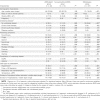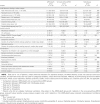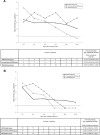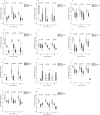Delayed clearance of viral load and marked cytokine activation in severe cases of pandemic H1N1 2009 influenza virus infection
- PMID: 20136415
- PMCID: PMC7107930
- DOI: 10.1086/650581
Delayed clearance of viral load and marked cytokine activation in severe cases of pandemic H1N1 2009 influenza virus infection
Abstract
Background: Infections caused by the pandemic H1N1 2009 influenza virus range from mild upper respiratory tract syndromes to fatal diseases. However, studies comparing virological and immunological profile of different clinical severity are lacking.
Methods: We conducted a retrospective cohort study of 74 patients with pandemic H1N1 infection, including 23 patients who either developed acute respiratory distress syndrome (ARDS) or died (ARDS-death group), 14 patients with desaturation requiring oxygen supplementation and who survived without ARDS (survived-without-ARDS group), and 37 patients with mild disease without desaturation (mild-disease group). We compared their pattern of clinical disease, viral load, and immunological profile.
Results: Patients with severe disease were older, more likely to be obese or having underlying diseases, and had lower respiratory tract symptoms, especially dyspnea at presentation. The ARDS-death group had a slower decline in nasopharyngeal viral loads, had higher plasma levels of proinflammatory cytokines and chemokines, and were more likely to have bacterial coinfections (30.4%), myocarditis (21.7%), or viremia (13.0%) than patients in the survived-without-ARDS or the mild-disease groups. Reactive hemophagocytosis, thrombotic phenomena, lymphoid atrophy, diffuse alveolar damage, and multiorgan dysfunction similar to fatal avian influenza A H5N1 infection were found at postmortem examinations.
Conclusions: The slower control of viral load and immunodysregulation in severe cases mandate the search for more effective antiviral and immunomodulatory regimens to stop the excessive cytokine activation resulting in ARDS and death.
Figures






References
-
- Chowell G, Bertozzi SM, Colchero MA, et al. Severe respiratory disease concurrent with the circulation of H1N1 influenza. N Engl J Med. 2009;361:674–679. - PubMed
-
- Trifonov V, Khiabanian H, Rabadan R. Geographic dependence, surveillance, and origins of the 2009 influenza A (H1N1) virus. N Engl J Med. 2009;361:115–119. - PubMed
Publication types
MeSH terms
Substances
LinkOut - more resources
Full Text Sources
Other Literature Sources
Medical

